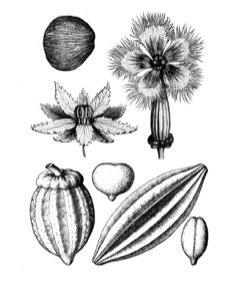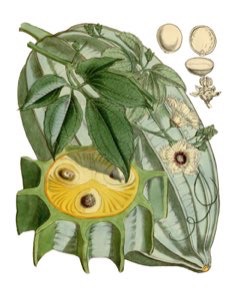 |
|
http://www.edibleplants.org |
 |
| http://www.edibleplants.org |
Translate this page:
Summary
Fluted Gourd, Telfairia occidentalis, is a perennial climbing, dioecious plant that can be found in West tropical Africa and can grow up to 15 m long. It is tolerant to drought and grown mainly for food and medicinal uses. The creamy white and red flowers occur in sets of five. The fruits, green when young then turns yellow upon ripening, are not edible but contain edible seeds that are high in protein and fat. The seeds can be eaten whole, ground into powder, or made into a fermented porridge. Seed oil is used in cooking. Young shoots and leaves of female plants of this species are consumed as vegetables. Medicinally, the plant is used for convulsion, malaria, anemia, and cardiovascular diseases. Propagation is by seeds.
Physical Characteristics

 Telfairia occidentalis is an evergreen Climber growing to 15 m (49ft) by 1 m (3ft 3in) at a fast rate.
Telfairia occidentalis is an evergreen Climber growing to 15 m (49ft) by 1 m (3ft 3in) at a fast rate.
See above for USDA hardiness. It is hardy to UK zone 10. The flowers are pollinated by Bees, Insects. The plant is not self-fertile.
Suitable for: light (sandy), medium (loamy) and heavy (clay) soils and prefers well-drained soil. Suitable pH: mildly acid and neutral soils and can grow in very acid soils.
It can grow in full shade (deep woodland) semi-shade (light woodland) or no shade. It prefers moist soil and can tolerate drought.
UK Hardiness Map
US Hardiness Map
Synonyms
Plant Habitats
Edible Uses
Edible Parts: Fruit Leaves Oil Seed Shoots
Edible Uses: Condiment Oil
Seed - cooked[46 ]. A pleasant almond-like flavour[301 ]. It can be boiled and eaten as a nut, or ground into a flour for use in soups[300 ]. Immature seeds are cooked or roasted; they can also be fermented for several days and eaten as a slurry[299 ]. Mature seeds are not consumed directly because they have a high content of antinutrients[299 ]. The raw flour shows better water and fat absorption properties than the oil, hence its useful application in baking products[299 ]. The seed contains up to 30% protein and a high content of a non-drying oil[300 ]. The large seeds are up to 5cm in diameter and are contained in a fruit that can weight up to 50kg[298 ]. The seeds have a very high oil content and are used to make a cooking oil[298 ]. The main constituents of the oil are oleic acid (37%), stearic and palmitic acid (both 21%), linoleic acid (15%). Variation between samples, however, is large[299 ]. Leaves and young shoots - cooked as a potherb[46 ]. The leaves are used alone or together with okra (Abelmoschus caillei and Abelmoschus esculentus), dika nut (Irvingia gabonensis), or egusi seeds (Citrullus lanatus and other species). They can also be mixed with eru (Gnetum africanum) and Pterocarpus soyauxii[299 ]. The young shoots, up to 50cm long, are used in stews and as a side dish[298 ]. The fruit pulp, including the young seeds, is occasionally made into marmalade[299 ].
References More on Edible Uses
Medicinal Uses
Plants For A Future can not take any responsibility for any adverse effects from the use of plants. Always seek advice from a professional before using a plant medicinally.
Tonic
Pregnant women, and patients suffering from anaemia, use the leaf juice as a tonic to strengthen the blood[299 ].
References More on Medicinal Uses
The Bookshop: Edible Plant Books
Our Latest books on Perennial Plants For Food Forests and Permaculture Gardens in paperback or digital formats.

Edible Tropical Plants
Food Forest Plants for Hotter Conditions: 250+ Plants For Tropical Food Forests & Permaculture Gardens.
More

Edible Temperate Plants
Plants for Your Food Forest: 500 Plants for Temperate Food Forests & Permaculture Gardens.
More

More Books
PFAF have eight books available in paperback and digital formats. Browse the shop for more information.
Shop Now
Other Uses
Fibre Oil Paint Varnish
Agroforestry Uses: Fluted pumpkin is often grown as a crop in homesteads, where it is intercropped with other vegetables and food crops such as cassava, yams and maize, or is planted against fences[299 ]. Other Uses The oil from the seeds is reported to be non-drying, and also to be used as drying oil for paints and varnishes[299 ]. The stems are macerated to produce fibres that are used as a sponge[299 ].
Special Uses
Carbon Farming Food Forest
References More on Other Uses
Cultivation details
Management: Standard Regional Crop Staple Crop: Protein-oil
Fluted pumpkin is a plant of the lowland, humid tropics, where it is found at elevations up to 1,000 metres[303 , 418 ]. It grows best in areas where annual daytime temperatures are within the range 21 - 30°c, but can tolerate 19 - 38°c[418 ]. The plant can survive temperatures down to about 5°c[418 ]. It prefers a mean annual rainfall in the range 1,900 - 2,200mm, but tolerates 1,500 - 2,700mm[418 ]. Succeeds in shade or full sun[300 ]. Tolerant of a wide range of soils[298 , 300 ], though a humus-rich, moist, fertile soil gives best yields[300 ]. Prefers a pH in the range 5 - 6, tolerating 4.5 - 7[418 ]. Established plants are drought resistant, though yields are greatly reduced in times of drought[298 , 300 ]. Fluted pumpkin grows fast in the warm, humid tropics, producing edible leaves in the rainy season and at the beginning of the dry season, for a period of 6 - 10 months[299 ]. The plant can be managed as a short-term perennial when grown on well-drained soils, slightly shaded and well mulched. On soggy soils and in sunlit spots it can only be grown as an annual. Female plants are usually grown for their edible young shoots since males do not produce many of these[300 ]. The first harvest of these shoots occurs about 2 - 3 months after sowing the seed[300 ]. Up to 15 harvests may be obtained during the following 120 - 160 days[418 ]. Male plants start to flower about 3 months after planting, a month earlier than females plants[299 ]. Hand pollination seems to be advantageous for fruit set as it resulted in 35% fruit set compared to 15% fruit set in open pollination[299 ]. Female plants produce about 18 single flowers which set fruit, but only 1 - 4 develop into mature fruits. Out of the female plants of a population, only 35% bear fruits. A large variation occurs between and within plants in the number of seeds per fruit, from 6 seeds per fruit up to 196, with an average of 62 seeds. The seeds are also unequal in size, varying in weight from 1 - 68g[299 ]. Fruits are ready about 5 - 6 months after sowing[299 , 300 ]. The fresh shoot yield can be as low as 500 - 1,000 kilos per hecttare, but it can also reach 3 - 10 tonnes. In home gardens in Benin, one plant occupying 3 metres of fence produced 2 kilos of young leaves per metre in the rainy season and 500g in the dry season without irrigation[299 ]. The seed yield can reach 1.9 tonnes per hctare, derived from 3,000 fruits[299 ]. A dioecious species, both male and female forms need to be grown if fruit and seed are required[299 ]. Identifying the female plants from either seeds or young seedlings has not been successful, but vine size 64 days after planting could be used as a sex indicator, because female plants are more vigorous than the male ones[299 ].
Carbon Farming
-
Management: Standard
Plants grow to their standard height. Harvest fruit, seeds, or other products. Non-Destructive management systems.
-
Regional Crop
These crops have been domesticated and cultivated regionally but have not been adopted elsewhere and are typically not traded globally, Examples in this broad category include perennial cottons and many nuts and staple fruits.
-
Staple Crop: Protein-oil
(16+ percent protein, 16+ percent oil). Annuals include soybeans, peanuts, sunflower seeds. Perennials include seeds, beans, nuts, and fruits such as almond, Brazil nut, pistachio, walnut, hazel, and safou.
References Carbon Farming Information and Carbon Sequestration Information
Temperature Converter
Type a value in the Celsius field to convert the value to Fahrenheit:
Fahrenheit:
The PFAF Bookshop
Plants For A Future have a number of books available in paperback and digital form. Book titles include Edible Plants, Edible Perennials, Edible Trees,Edible Shrubs, Woodland Gardening, and Temperate Food Forest Plants. Our new book is Food Forest Plants For Hotter Conditions (Tropical and Sub-Tropical).
Shop Now
Plant Propagation
Seed - can be sown in situ or in containers. When grown in containers, sow 2 - 3 seeds in each container thinning to the strongest plant once they germinate[300 ]. Seed size affects the vigour, germination rates and establishment of the seedlings. Viability varies from 63% for small seeds weighing less than 11g, up to 89% for seeds weighing 22g. Germination takes about 14 days in natural soil, but only 7 days in a sawdust medium. Vine length one week after emergence is on average 31cm for large seeds, whereas small size seeds grow into a corresponding vine length of 16cm Plant out container-grown plants after about 30 days[300 ]. Some seeds exhibit polyembryony, producing more than one seedling[299 ]. The seed is recalcitrant in nature. They often germinate whilst still in the fruit and have a short viability, thus seed storage is difficult[299 ]. The critical seed moisture content below which seeds cannot recover from desiccation is 40 - 60%[299 ]. Layering. Very easy[63 ].
Other Names
If available other names are mentioned here
Apiroko, Calabaza, Emeke, Gonugbe, Iroko, Krobonko, Oysternut, Pondokoko, Ubong, Ugu, Umee, Umwenkhen, ugwu (i) .
Native Range
AFRICA: Uganda, Ghana, Nigeria, Sierra Leone, Angola.
Weed Potential
Right plant wrong place. We are currently updating this section.
Please note that a plant may be invasive in one area but may not in your area so it's worth checking.
Conservation Status
IUCN Red List of Threatened Plants Status : This taxon has not yet been assessed

Growth: S = slow M = medium F = fast. Soil: L = light (sandy) M = medium H = heavy (clay). pH: A = acid N = neutral B = basic (alkaline). Shade: F = full shade S = semi-shade N = no shade. Moisture: D = dry M = Moist We = wet Wa = water.
Now available:
Food Forest Plants for Mediterranean Conditions
350+ Perennial Plants For Mediterranean and Drier Food Forests and Permaculture Gardens.
[Paperback and eBook]
This is the third in Plants For A Future's series of plant guides for food forests tailored to
specific climate zones. Following volumes on temperate and tropical ecosystems, this book focuses
on species suited to Mediterranean conditions—regions with hot, dry summers and cool, wet winters,
often facing the added challenge of climate change.
Read More
Expert comment
Author
Hook.f.
Botanical References
Links / References
For a list of references used on this page please go here
A special thanks to Ken Fern for some of the information used on this page.
Readers comment
| Add a comment |
|
If you have important information about this plant that may help other users please add a comment or link below. Only comments or links that are felt to be directly relevant to a plant will be included. If you think a comment/link or information contained on this page is inaccurate or misleading we would welcome your feedback at [email protected]. If you have questions about a plant please use the Forum on this website as we do not have the resources to answer questions ourselves.
* Please note: the comments by website users are not necessarily those held by PFAF and may give misleading or inaccurate information.
To leave a comment please Register or login here All comments need to be approved so will not appear immediately.
|
Subject : Telfairia occidentalis
|
|
|
|